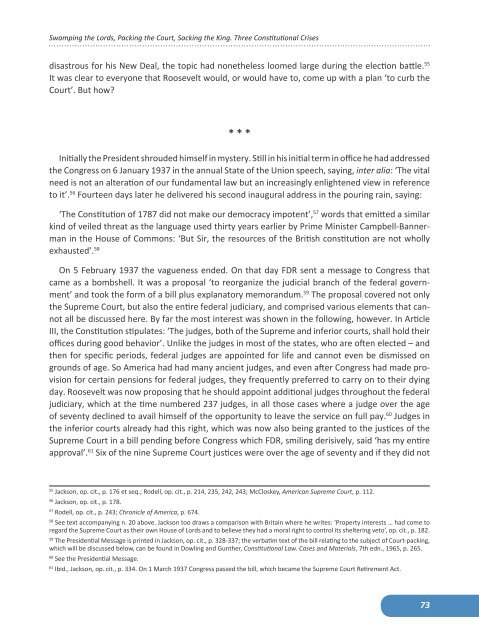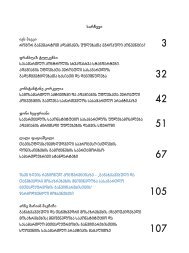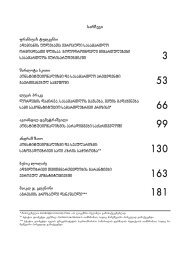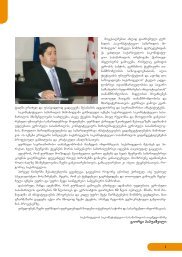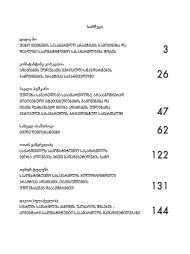Contents - Constitutional Court of Georgia
Contents - Constitutional Court of Georgia
Contents - Constitutional Court of Georgia
Create successful ePaper yourself
Turn your PDF publications into a flip-book with our unique Google optimized e-Paper software.
Swamping the Lords, Packing the <strong>Court</strong>, Sacking the King. Three <strong>Constitutional</strong> Crises<br />
disastrous for his New Deal, the topic had nonetheless loomed large during the election battle. 55<br />
It was clear to everyone that Roosevelt would, or would have to, come up with a plan ‘to curb the<br />
<strong>Court</strong>’. But how?<br />
* * *<br />
Initially the President shrouded himself in mystery. Still in his initial term in <strong>of</strong>fice he had addresse d<br />
the Congress on 6 January 1937 in the annual State <strong>of</strong> the Union speech, saying, inter alia: ‘The vital<br />
need is not an alteration <strong>of</strong> our fundamental law but an increasingly enlightened view in reference<br />
to it’. 56 Fourteen days later he delivered his second inaugural address in the pouring rain, saying:<br />
‘The Constitution <strong>of</strong> 1787 did not make our democracy impotent’, 57 words that emitted a similar<br />
kind <strong>of</strong> veiled threat as the language used thirty years earlier by Prime Minister Campbell-Bannerman<br />
in the House <strong>of</strong> Commons: ‘But Sir, the resources <strong>of</strong> the British constitution are not wholly<br />
exhausted’. 58<br />
On 5 February 1937 the vagueness ended. On that day FDR sent a message to Congress that<br />
came as a bombshell. It was a proposal ‘to reorganize the judicial branch <strong>of</strong> the federal government’<br />
and took the form <strong>of</strong> a bill plus explanatory memorandum. 59 The proposal covered not only<br />
the Supreme <strong>Court</strong>, but also the entire federal judiciary, and comprised various elements that cannot<br />
all be discussed here. By far the most interest was shown in the following, however. In Article<br />
III, the Constitution stipulates: ‘The judges, both <strong>of</strong> the Supreme and inferior courts, shall hold their<br />
<strong>of</strong>fices during good behavior’. Unlike the judges in most <strong>of</strong> the states, who are <strong>of</strong>ten elected – and<br />
then for specific periods, federal judges are appointed for life and cannot even be dismissed on<br />
grounds <strong>of</strong> age. So America had had many ancient judges, and even after Congress had made provision<br />
for certain pensions for federal judges, they frequently preferred to carry on to their dying<br />
day. Roosevelt was now proposing that he should appoint additional judges throughout the federal<br />
judiciary, which at the time numbered 237 judges, in all those cases where a judge over the age<br />
<strong>of</strong> seventy declined to avail himself <strong>of</strong> the opportunity to leave the service on full pay. 60 Judges in<br />
the inferior courts already had this right, which was now also being granted to the justices <strong>of</strong> the<br />
Supreme <strong>Court</strong> in a bill pending before Congress which FDR, smiling derisively, said ‘has my entire<br />
approval’. 61 Six <strong>of</strong> the nine Supreme <strong>Court</strong> justices were over the age <strong>of</strong> seventy and if they did not<br />
55 Jackson, op. cit., p. 176 et seq.; Rodell, op. cit., p. 214, 235, 242, 243; McCloskey, American Supreme <strong>Court</strong>, p. 112.<br />
56 Jackson, op. cit., p. 178.<br />
57 Rodell, op. cit., p. 243; Chronicle <strong>of</strong> America, p. 674.<br />
58 See text accompanying n. 20 above. Jackson too draws a comparison with Britain where he writes: ‘Property interests … had come to<br />
regard the Supreme <strong>Court</strong> as their own House <strong>of</strong> Lords and to believe they had a moral right to control its sheltering veto’, op. cit., p. 182.<br />
59 The Presidential Message is printed in Jackson, op. cit., p. 328-337; the verbatim text <strong>of</strong> the bill relating to the subject <strong>of</strong> <strong>Court</strong>-packing,<br />
which will be discussed below, can be found in Dowling and Gunther, <strong>Constitutional</strong> Law. Cases and Materials, 7th edn., 1965, p. 265.<br />
60 See the Presidential Message.<br />
61 Ibid., Jackson, op. cit., p. 334. On 1 March 1937 Congress passed the bill, which became the Supreme <strong>Court</strong> Retirement Act.<br />
73


